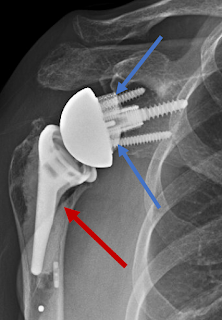A 75 year old woman had a reverse total shoulder after two failed rotator cuff repair attempts. As we recognize this indicates three risk factors for acromial stress fracture: female sex, advanced age, and rotator cuff disease.
Three months after surgery, she developed pain in her posterior acromion. An acromial stress fracture was diagnosed on subsequent CT scan.
It has been suggested that component selection and position may increase the risk of acromial stress fractures (see for example Lateralized reverse total shoulder: abduction damage to the acromion).
In this case the augmented baseplate lateralized the glenosphere while the varus position of the humeral component lateralized the greater tuberosity.
As a result the tuberosity was at risk for collision with the acromion on abduction.
Follow on twitter: https://twitter.com/RickMatsen or https://twitter.com/shoulderarth
Follow on facebook: click on this link
Follow on facebook: https://www.facebook.com/frederick.matsen
Follow on LinkedIn: https://www.linkedin.com/in/rick-matsen-88b1a8133/
Here are some videos that are of shoulder interest
Shoulder arthritis - what you need to know (see this link).
How to x-ray the shoulder (see this link).
The ream and run procedure (see this link).
The total shoulder arthroplasty (see this link).
The cuff tear arthropathy arthroplasty (see this link).
The reverse total shoulder arthroplasty (see this link).
The smooth and move procedure for irreparable rotator cuff tears (see this link).
Shoulder rehabilitation exercises (see this link).







